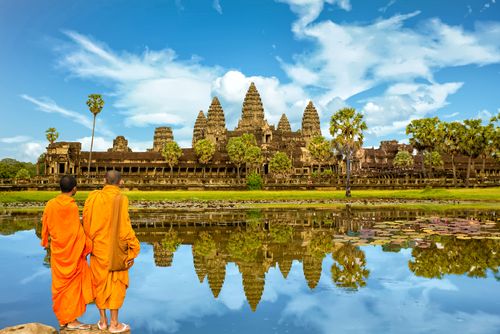 An ancient religious site in Cambodia has recently become a place of concern due to reported human rights violations. Amnesty International has accused the Cambodian government of evicting families who have lived next to the Angkor Temple Complex for generations. The Cambodian government claims that local residents threaten the preservation of the country's historical heritage in the area, but critics argue that the authoritative regime is choosing tourism over human rights.
An ancient religious site in Cambodia has recently become a place of concern due to reported human rights violations. Amnesty International has accused the Cambodian government of evicting families who have lived next to the Angkor Temple Complex for generations. The Cambodian government claims that local residents threaten the preservation of the country's historical heritage in the area, but critics argue that the authoritative regime is choosing tourism over human rights.
What Is the Angkor Temple Complex in Cambodia?
The Angkor Temple Complex in Cambodia is the largest religious structure in the world and became a UNESCO World Heritage site in 1992. The area encompasses 402 acres and features 72 major religious monuments, with hundreds more dotting the landscape. The centerpiece, Angkor Wat, is not only a stunning architectural marvel but also a sacred religious site. Built in the 12th century, it attracts millions of tourists each year, contributing significantly to Cambodia's tourism industry.
The temples that people can visit today are remnants of one of Southeast Asia's most impressive empires, the Empire of Angkor. The ancestral kings of Cambodia added temples to the area now known as Siem Reap over many generations and hundreds of years, including structures to honor gods such as Shiva, Brahma, and the Buddha in his many forms and incarnations. The people of Cambodia practice Theravada Buddhism and consider Angkor to be a sacred place to this day.
What Is Happening to Local Residents at Angkor?
Amnesty International's recent report sheds light on the dire situation faced by local residents near the Angkor Temple Complex. Cambodian authorities have forced approximately 10,000 families to leave their homes, a move that the human rights organization argues violates both international and national laws.
The families uprooted by the government received little to no compensation and are struggling to live at improper resettlement sites. The areas designated for the displaced lack essential facilities such as roads, clean water, electricity, and sanitation. The inconvenient location is nearly an hour away from Angkor by motorcycle, which is a problem for many families who rely on jobs related to tourism at Angkor to survive.
Why Is the Cambodian Government Evicting People?
The Cambodian government claims that the preservation of the Angkor Temple Complex is a top priority and that the people who live in the vicinity of the temples endanger the sacred sites by farming, working, and living their daily lives. Cambodian leaders have attempted to justify the displacement of local families by pointing to the fact that the area is a UNESCO World Heritage Site and shouldn't house a local population. This raises concerns about the misuse of cultural preservation efforts.
Critics of the Cambodian government argue that the real reason behind the evictions is tourism. The tourism industry brings in around 11% of the country's gross domestic product, according to the Asian Development Bank, and during the COVID-10 pandemic, tourism numbers dwindled. By moving local people away from Angkor Wat, the government can enact plans to develop the area and gentrify it for the sake of tourists.
What Is the Recent History of Human Rights in Cambodia Like?
The current accusations of human rights violations from Amnesty International are far from unique for Cambodia. Under the authoritarian rule of Prime Minister Hun Sen, the country has seen increased crackdowns on freedom of speech, the right to protest, and the right to housing. The Angkor evictions are not even the first time the government has forcibly removed people in order to sell land to developers.
The unfolding events around the Angkor Temple Complex in Cambodia reveal a distressing intersection of cultural preservation, economic interests, and human rights violations. The forced evictions of local residents, coupled with inadequate compensation and resettlement conditions, demand international attention and scrutiny.



